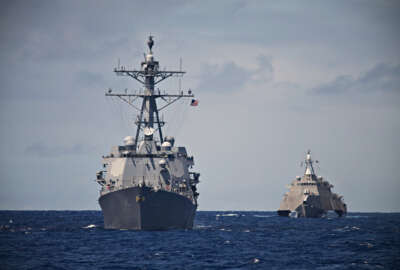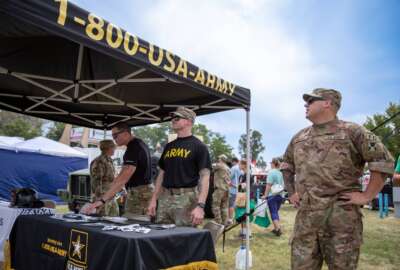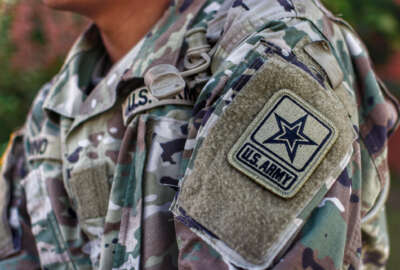Sponsored by Verizon
Army makes more IT organization changes in pursuit of unified network
The concept of a single network from soldiers' home stations to the tactical edge isn't new, but Army leaders say cultural changes are finally making it happen.
The Army is beginning fiscal 2025 with some notable changes to the organizations that have long had a hand in building and maintaining its network and communications capabilities, all with the hope of finally achieving an objective officials have talked about for a decade or more: an IT and data ecosystem that gives soldiers the same capabilities irrespective of where in the world they happen to be.
The changes weave together themes the Army has discussed extensively in recent years: the concept of a unified network rather than separate “enterprise” and “tactical” networks, and that also makes data ubiquitous and secure. But officials say they’re also reflective of a culture change that will finally enable all of those things to happen.
For one, the Army’s Network Enterprise Technology Command (NETCOM), is pivoting from being the organization that focuses mainly on operating and maintaining its network infrastructure to more of an all-in-one provider for critical services like cybersecurity and identity management.
“We’re going to really start focusing on not only delivering that network, but everything that’s going through that network … we’re going to have global collaboration tools that are going to be available to us, both horizontally and vertically — letting our theaters talk to one another, and going up and down through the Army,” Maj. Gen. Denise McPhail, NETCOM’s commander, told attendees at a recent AUSA conference. “It really means being able to pick up your system [when you deploy] and not have to re-image it over and over. Now, you’re not going to have to do that. You’re going to have seamless movement across the globe.”
Organizational rebranding
The Army has also made some organizational nomenclature changes over the last several months that are in some ways cosmetic, but that officials say are a reflection of a genuine cultural shift: a recognition that the Army’s networks, its data, and its connectivity are inextricably linked together.
That’s a reality the Army may not have fully realized as recently as 2018, when one of the largest reorganizations in its recent history resulted in the standup of Army Futures Command and the creation of what has, since then, been called the Army Network Cross-Functional Team.
That CFT, as of last month, is now called the Command-and-Control Cross-Functional Team, said Maj. Gen. Patrick Ellis, who took lead of the team earlier this year.
“I think that really reemphasizes the importance of the fact that we’re taking on command and control — we’re so much more than just a network. The network needs to be something that leads to data, and data leads to better decisions,” he said. “Part of the reason we’ve been redesignated is to reflect where we’ve been, but my job is also to put the commander back in command and control, and to enable the commander to make better, faster and more optimized decisions at a high rate of speed.”
One acquisition organization for unified network
One way to do that is to make the Army’s acquisition decisions around its networking capabilities much more flexible — especially the ones that relate to the exact types of equipment soldiers might travel with and deploy as part of command posts in distant locations.
That’s largely the job of another organization that has a new name: the Program Executive Office for Command, Control, Communications and Networks (PEO-C3N). Until recently, it was called PEO-C3T — with the “T” standing for tactical.
But the Army has decided it makes much more sense to have one acquisition organization in charge of network-related procurement decisions, said Mark Kitz, the program executive officer for the newly-named organization.
“You’re seeing requirements and acquisition integration across our entire unified network. PEO-C3N now owns the entire unified network, but you’re seeing collaboration between the command and control cross-functional team, NETCOM, and the G6 community,” he said. “We are now truly treating this network as a unified network, and I would say that behavior in industry has to match sort of this cultural behavior on the government side.”
As for what that means on the ground, the Army said it wants vendors to offer solutions that are compatible with ubiquitous connectivity, and the idea that there’s never going to be a one-size-fits-all approach to an Army command post in the future.
Instead, commanders will need the flexibility to tailor their approaches to the connectivity options available to them and the mission requirements in front of them.
“A lot of that looks like things that you’re already familiar with: low Earth orbit capability and some additional radio capability,” Ellis said. “We’re enabling the command post by making it a little bit more modular, as opposed to having a big, monolithic command post where every one looks the same. We want to put tools in the hands of the commanders that allow them to scale up and scale down, reconfigure their command post as they need to, based on the mission, and how the commander chooses to command. That’s something we were able to observe watching the conflict in Europe: the command posts were constantly changing as a result of the battlefield.”
Next Generation Command and Control
The Army is hoping to tie all those efforts together — and figure out where to go next — via an initiative called Next Generation Command and Control.
The service published a request for information on Sept. 30 asking vendors for input on how the Army might build a system-of-systems approach to ways that would let companies plug in to the Army’s Unified Data Reference Architecture (UDRA) — the service’s new framework for making data more accessible across the entire organization.
“We’re going to look hard at data integration across all domains,” said Maj. Gen. Jeth Rey, who is expected to become the next deputy Army chief of staff for cyber and IT issues when Lt. Gen. John Morrison leaves the post early next calendar year. “We’re going to look at more AI and machine learning that we’re going to put against that data in order to enrich it for the user and for the warfighter. We’re going to strengthen data in our governance, in our security across domains as well. We’re going to leverage cloud at the edge computing, because we want to bridge our tactical and strategic as we look at the unified network.”
Copyright © 2024 Federal News Network. All rights reserved. This website is not intended for users located within the European Economic Area.
Jared Serbu is deputy editor of Federal News Network and reports on the Defense Department’s contracting, legislative, workforce and IT issues.
Follow @jserbuWFED






